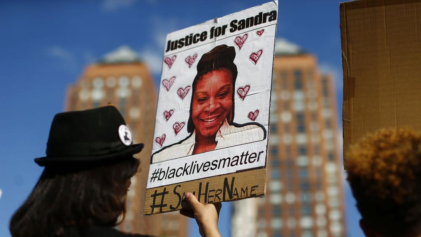When Sandra Bland, a Black woman arrested for a minor traffic stop, died in a Texas jail, it became an international story exposing the problems in the criminal justice system. Unfortunately jailhouse deaths are not unusual. Four other Black women died in jail after Bland’s death.
And now, Samuel Harrell, an inmate at the Fishkill Correctional Facility who died after a beating from up to 20 prison guards, has been ruled a homicide.
Harrell, who suffered from bipolar disorder had been acting erratically. The New York Times reports that other inmates said he looked like he was depressed and had said his family was coming to take him home. The inmates said correctional officers were called to respond to Harrell and he may have panicked when he was surrounded by 20 prison guards.
What transpired next can only be described as a sustained assault.
“I saw the officers kicking him, jumping on his head multiple times and screaming, ‘Stop resisting,’ even though I didn’t see him moving,” Edwin Pearson, who has since been released after serving two years on a weapons charge told The New York Times.
However, even after Harrell lay motionless on the floor, the assault didn’t end there. According to the inmates’ accounts, Harrell was then thrown or dragged down a staircase. One inmate reported seeing him lying on the landing, “bent in an impossible position,” according to a New York Times investigation.
Harrell was assaulted by a group of correctional officers so well known for violence, inmates called them “The Beat Up Squad.” One of the prison guards allegedly involved in the assault of Harrell has an extensive record of abusing inmates. Sgt. Joseph Guarino, 60, has been sued several times by inmates accusing him of brutality. One case was settled by the state in 2012 for $60,000 and another in 2011 for $65,000. In a 2011 deposition, he said inmates typically filed about 30 grievances against him a year and referred to him by the nickname Sergeant Searchalot.
Another inmate at the Fishkill Correctional Facility also complained of being severely beaten. In July, Rickey Rodriguez said that officers beat him so severely that he lost his two front teeth and had to be hospitalized. When The New York Times interviewed him a little more than a week after he was released from prison, Rodriguez was still covered with cuts and bruises, and the white of his right eye was stained red with blood.
The New York Times reports that finding information about prisoner abuse was difficult because many inmates feared retribution if they talked. The publication pieced together the events leading to Harrell’s death from 19 affidavits and letters written by inmates and obtained through the law firm Beldock, Levine & Hoffman, which is representing Mr. Harrell’s family.
“Most of the inmates shared their affidavits on the condition that their names not be used, because they said they feared retribution from corrections officers,” The New York Times said.
The inmates’ fears are justified. According to Luna Droubi, a lawyer with Beldock, Levine & Hoffman, at least nine inmates had been placed in solitary confinement after they cooperated with the investigation.
While the deaths of Bland and Harrell may be shocking to the American public, they really shouldn’t be. Torture and prisoner deaths are quite common in the correctional system. The New York Times reported several inmates at the Clinton Correctional Facility in Dannemora, N.Y., said they were beaten and suffocated with plastic bags by prison guards trying to find out information about two inmates involved in a high-profile escape.
The City of Chicago recently paid $5.5 million in reparations to Black men who were tortured by a group of officers lead by police commander Jon Burge. Some of the tactics Burge used, such as suffocation and electrocution, were learned when he served as an interrogator in Vietnam. And even more disturbing, there is a link between prisoner abuse and the war on terror. Torture at Abu Ghraib and Guantanamo Bay was conducted by American law enforcement officials. Chicago police officer Richard Zuley used techniques that resembled those he enacted when he took over the interrogation of Mohamedou Ould Slaihi at Guantánmo.



